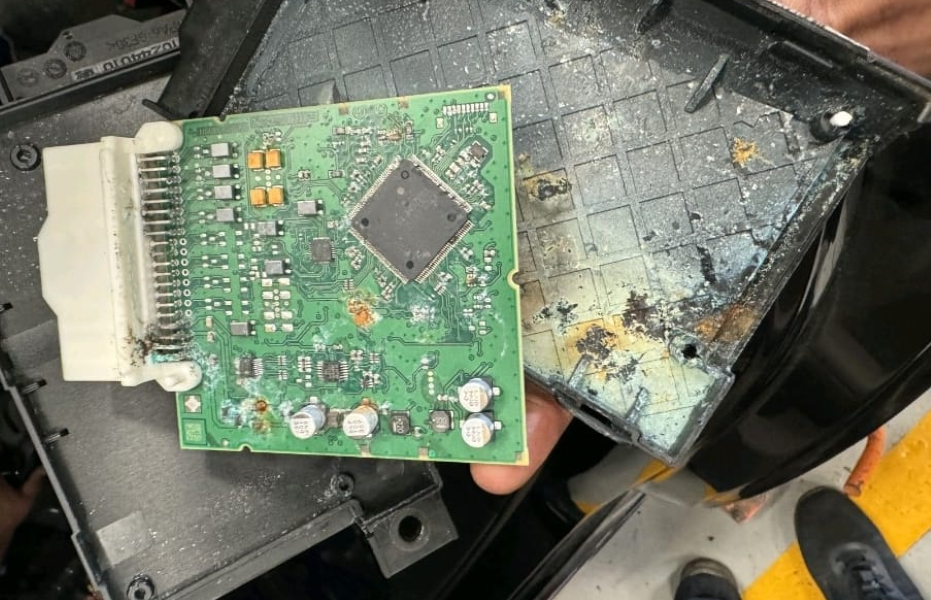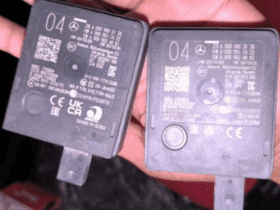Table of Contents
Solving the “Car Won’t Start” Problem: A Mercedes C-Class W205 Case Study
When a car won’t start, frustration quickly follows especially when it’s a premium model like the Mercedes-Benz C-Class W205. Even with the latest technology, issues such as communication faults, water ingress, or damaged CAN wiring can leave the car completely unresponsive.
In this detailed case study, we’ll walk through how a Mercedes dealership technician diagnosed and resolved a complex no-start condition in a C-Class W205, restoring the vehicle to full operation.
Customer Complaint: Car Won’t Start
The owner reported that their Mercedes C-Class W205 would not start despite all dashboard lights illuminating normally. The vehicle was towed to the dealership for a full diagnosis and repair.
1. Initial Diagnosis with XENTRY
Using Mercedes-Benz XENTRY Diagnostics, the technician performed a complete system scan.
Findings:
- – Multiple communication fault codes appeared across various control units.
- – The issue pointed toward a network fault in the CAN bus or a damaged control module affecting drivetrain communication.
This initial finding ruled out basic issues like a flat battery or starter motor failure.

2. Diagnostic Process
Step 1 : Voltage Supply Verification
The technician verified the voltage supply to the Central Control Module (CCM).
- – Voltage: Within normal range
- – Power supply integrity: Confirmed
No issues were detected in the main power circuit.
Step 2 : CAN Bus Resistance Check
A resistance check was performed at the potential distributor to measure terminal resistance on the Low-Speed CAN (Interior Bus).
- – Expected value: ≈60 Ω
- – Measured value: Abnormal
This indicated an open or short circuit on the low CAN lines a likely cause of disrupted communication between modules.

Step 3 : Repair Attempt on CAN Wires
The technician repaired the Low CAN wiring that showed inconsistent readings.
However, despite restoration efforts, the car still wouldn’t start, suggesting a deeper fault possibly within a control unit itself.

Step 4 : Inspection of the Central Control Module
The Central Control Module (N10/2) was removed for closer examination.
Upon inspection, water penetration was discovered inside the module connector a critical finding.
Moisture had caused corrosion and shorting, effectively cutting communication between modules and preventing the car from starting.


3. Repair & Resolution
Actions Taken:
- 1. Replaced the Central Control Module with a genuine Mercedes-Benz part.
- 2. Cleaned and sealed the connectors to prevent future water ingress.
- 3. Re-checked CAN resistance normal at 60 Ω.
- 4. Cleared all fault codes and reprogrammed the new module using XENTRY.
Result:
– Communication restored across all control units.
– Engine started immediately with no further errors.
– Vehicle returned to full working condition.

4. Outcome Summary
| Issue | Root Cause | Resolution |
|---|---|---|
| Vehicle won’t start | Internal short in Central Control Module | Replaced module |
| CAN network error | Water contamination | Cleaned and sealed connectors |
| Persistent communication fault | Damaged internal circuit | Verified after reprogramming |

5. Lessons Learned
This case underscores the value of a structured diagnostic workflow rather than random component replacement.
Key Takeaways:
- – Always check network integrity (CAN, FlexRay) early in the process.
- – Water intrusion is a frequent and easily overlooked cause of no-start conditions.
- – Verify module voltage supply and resistance values before assuming ECU failure.
6. What to Check When a Car Won’t Start
| Category | What to Inspect | Possible Fix |
|---|---|---|
| Battery & Power | Battery voltage, corrosion, ground straps | Recharge or replace, clean terminals |
| Starter Circuit | Starter relay, solenoid, wiring | Test relay, replace starter motor if faulty |
| Fuel System | Fuel pump, fuel filter, injectors | Check pressure, replace filter or pump |
| Ignition System | Spark plugs, coils, crank sensor | Replace faulty plugs or coils |
| ECU & CAN Network | Module communication, wiring integrity | Scan with XENTRY, repair CAN lines |
| Security System | Key fob battery, ESL/EZS lock | Replace key battery, reinitialize module |
By following this systematic checklist, technicians can quickly isolate whether the problem is electrical, communication-based, or mechanical.
Related Diagnostic Resource
If you’re facing similar starting problems, explore our full troubleshooting hub:
Mercedes No Start Issues: Causes, Fixes & Case Studies : a complete guide covering electrical, fuel, and ECU-related no-start scenarios across multiple Mercedes models.
Prevention Tips
- – Avoid parking near areas prone to water pooling or heavy rain exposure.
- – Regularly inspect the fuse box and control module covers for moisture.
- – Perform periodic CAN resistance checks during routine maintenance.
- – Keep connectors sealed with dielectric grease to block moisture and corrosion.
FAQ
1. Can a car’s lights work but still not start?
Yes, lights draw minimal current, while the starter and control modules require full voltage and proper CAN communication.
2. What happens when a Central Control Module fails?
It can disrupt communication between key systems (EZS, TCU, ECU), completely preventing the car from starting.
3. How can I prevent module water damage?
Ensure seals, grommets, and cowl drains are clear, and use moisture-repellent sprays on connectors after service.
Author Bio
Written by Mercedes Expert
With years of hands-on experience diagnosing and repairing Mercedes-Benz systems, he brings technical depth and practical case studies to help car owners, technicians, and enthusiasts troubleshoot complex automotive issues. His work focuses on clear repair guides, OEM-level procedures, and knowledge-sharing to empower both professionals and drivers.
Last update: October 2025






Leave a Reply